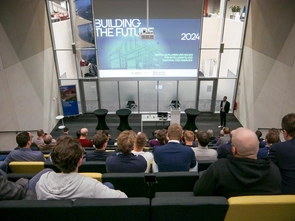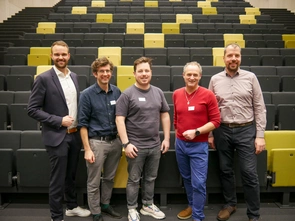Up to ten percent lower construction costs with digital twin
The development of digital tools for more efficient planning and construction is advancing at a rapid pace. Planning is becoming more precise, collaborative and construction sites are becoming more transparent. For example, digital twins of buildings – especially when it comes to renovation – can save significant construction costs, experts agree at the “Building the Future” conference at the Johannes Kepler University in Linz, hosted by Drees & Sommer and qapture.
Linz, 24 January 2023. Just how advanced the possibilities of digital planning and construction are today was recently demonstrated at the “Building the Future” conference at the Johannes Kepler University in Linz. The real estate planning and project management company Drees & Sommer, together with the Linz startup “qapture”, which specializes in “reality capture”, recently invited industry representatives to inform about the latest developments and current examples of applications of digital tools for intelligent and sustainable buildings.
“If you look at the way we design buildings today, a big change is taking place,” explains Matthias Mayr, Head of Drees & Sommer Linz. “The complexity of the projects is increasing dramatically, as is the pressure on deadlines and the density of information in a project. At the moment, the challenge is to take the complexity out of projects and to provide the relevant target groups in the project with the information they really need. The key to more efficient and collaborative planning is the digital planning method BIM (Building Information Modelling).”
Managing the building data correctly
While BIM was initially primarily used in building planning, the method is now being extended to all phases of a building cycle: from planning to construction to operation. “In order to minimise the ecological footprint of a building in the best possible way and to develop an optimised design result, it is essential to collect data, update it and continuously evaluate it. “But above all, it is important to extract the relevant data from this enormous flood of data and to manage it,” explains Hannes Asmera, BIM expert at Drees & Sommer Austria. Use of BIM and efficient data management to contribute to more sustainable and resource-efficient buildings and to make planning and construction processes even more efficient and collaborative, involving all project stakeholders.”
Sparkasse Oberösterreich as best practice
For example, BIM is also being used in the renovation of the Sparkasse Oberösterreich’s headquarters on the Promenade in Linz. In addition to planning the renovation of the listed building, a particular challenge for this project is the in-depth approach to sustainability with the integration of circular economy. “And in order to implement the latter, we first have to survey the existing building stock,” explains Christof Löffler, a circular economy expert at Drees & Sommer’s subsidiary EPEA, commissioned by Sparkasse OÖ. The Linz startup “qapture”, which specializes in reality capture, was commissioned for this project. Laser scanners scanned the entire building and created a digital twin of the building,” says Daniel Höller, CEO of qapture. “Not only did it capture all the real dimensions of the building in detail, it also enabled us to automatically capture the inventory.” On this basis, the detailed planning of the project can now take place.
Local construction supervision with a digital twin
However, the digital twin of a building is now also being incorporated into the local building inspectorate (ÖBA). “If I have my way, we can gradually take out the construction diary that we used to work with,” explains Otto Eichler of EOTEC, a company specialising in automation solutions in building management. “In one of our current major projects, we started to scan the building every week and continuously check the progress of the construction site with the planning. This makes it possible to detect and correct errors quickly.” Above all, however, the construction site is becoming more transparent and efficient. The project in Germany recently saved around 2.5 percent of construction costs compared to conventional methods. Deadlines could be met better,” explains Daniel Höller.“ I am convinced that the digital twin is essential in the renovation of existing buildings in particular,” says Otto Eichler. “I think that, compared to conventional methods of ÖBA, the digital twin can save up to ten percent of costs in the renovation of existing buildings in the future.”
Paradigm shift
Digital tools such as BIM or the digital twin are not yet widely used in Austria. “A paradigm shift is needed for these to really become established,” explains Daniel Höller. The design standard in Austria is currently still 2D. In Germany, calls for 3D planning are increasingly being made for tenders. “2D planning is usually faster, 3D planning makes a lot easier and it has also become technically simpler,” explains Höller. “However, 3D planning needs to be given even more weight in the training of planners in the future if the technology is to become widely accepted.”

